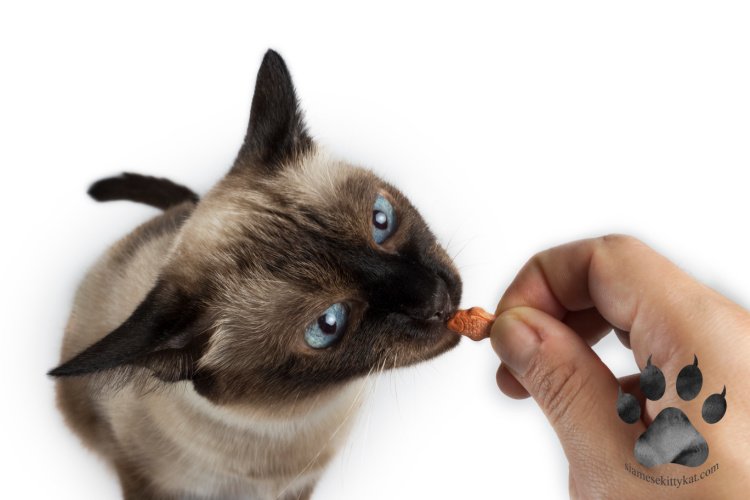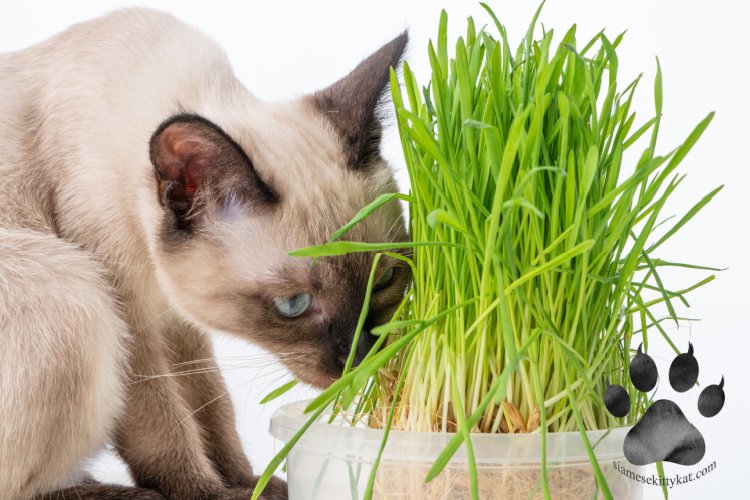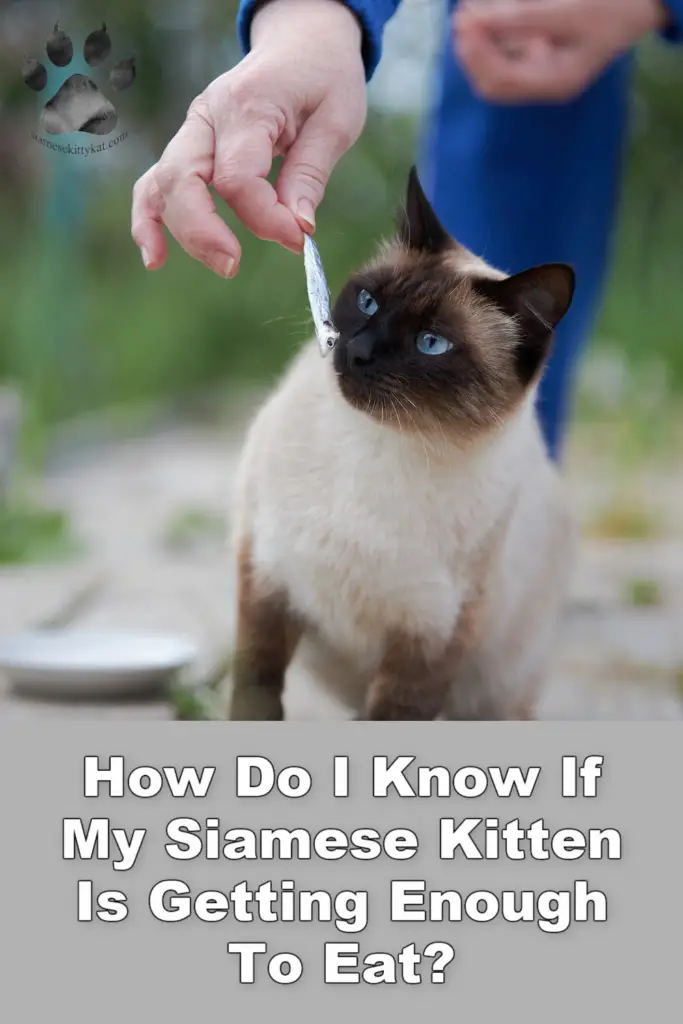How much should kittens eat per day?
Not only are kittens incredibly cute, but they also have a huge appetite. Their weight can double – or even triple – during the first couple of weeks after they are born.
Just like human babies, Siamese kittens are growing every day, therefore they need lots of nutrition to support their high activity and energy levels. These activity levels can make it harder to ensure kittens are getting enough to eat.
Most kittens will feel the need to eat three or four times a day. However, the amount of times you feed them per day depends on the type of food you’re giving them.
Wet food should be given 4 times a day, and a combination of wet and dry food should be given 2 times per day.
Check below to find out the recommended food amount for your kitten’s age:
For a kitten, this young, milk from their mother is the best way to go. However, in some circumstances this is impossible, and the kitten will have to be hand-fed.
In this situation, your kitten should be given 8ML of kitten milk per ounce of body weight.
During the first week of this stage, your kitten should be fed a 3 part kitten milk mixture with 1 part dry kitten food. For the following week, you should give your Siamese 2 parts kitten milk with 1 part dry kitten food.
During this stage, the aim of the game is to slowly wean the kitten off the milk and onto solid food only.
During this point in their lives, your Siamese will be hungry all the time. They are growing, after all. Therefore, you’ll want to feed them at least 4 times a day. Amount wise, it should be ⅓ to ¾ of a cup per feeding session.
During this stage of their lives, you can reduce the feeding times to 3 times per day and up the amount to 1 cup of kitten food per session.
If you choose to feed them wet food, this can be measured by giving them ⅔ of a 3 ounce can for every pound of their body weight.
During the final 6 months of kittenhood, you can feed your Siamese ½ of a 3 ounce can of kitten good per one pound of body weight.
What should I feed my Siamese kitten?

Since there are so many options available, it can be an absolute headache when it comes to choosing the right one for your Siamese.
Felines are obligate carnivores, which means they mainly stick to an all-meat diet. Most of their diet should be made up of protein, and only 5% should consist of carbohydrates.
That’s why many people stray away from feeding their kitties only dry food. It’s basically impossible to accomplish a balanced diet with commercially available dry food as it mainly contains carbohydrates, plant protein, fillers, and ingredients not recommended for your kitty.
Even if the brand claims they offer a balanced diet, it’s likely not to be true.
An important thing you have to consider is how much water your Siamese is consuming. Not many people know that cats, especially ones in the wild, get most of their hydration from their food and not drinking water.
Whereas wet food is made up of 70-80% water, dry food is a mere 10%. Of course, they can hydrate themselves by drinking water, but it’s rarely enough to make up for the loss.
The most expensive way to feed your Siamese is by keeping them on a raw food diet. This diet consists of meats that are uncooked or somewhat cooked, and resembles the natural diet they would eat in the wild.
Many people attest to the fact this is the best way to ensure your Siamese gets all the nutrients they need. This raw food can either be specially made and purchased for cats or simply prepared at home.
Taking all that into consideration, the best way to ensure your Siamese gets all their nutrients are sticking to wet food, with a supplement of dry food every now and again. That is assuming they don’t have any special dietary requirements, of course.
It’s also important to remember that you get what you pay for. If you can afford it, it’s well worth paying the extra bucks for some good quality food as opposed to something on sale.
If you’re still unsure what diet is best for your Siamese, you can always consult your vet to see what they recommend. All kitties are different, so a personalized diet would be great for them.
In one of my recent blogs, I explored which is better for your Siamese cat, wet food or dry food? Aside from providing nutrition, you will be surprised to know there are a lot more benefits to feeding your cat wet food! Discover them by clicking on the link.
How do I know if I am feeding my cat enough?
If you’re wondering whether or not your feeding your Siamese the right amount of food, check where your cat lies on the chart below:
Keep in mind that Siamese kitties are skinny by nature. However, this should never be too extreme to the point it looks unhealthy.
| Too Thin |
|---|
| On shorthaired cats, the ribs will be clearly visible. There will be no palpable fat and a severe abdominal tuck. Their legs will be incredibly skinny and their bones will be visible. |
| Ribs will be clearly visible and will have little to no palpable fat. Their muscle mass will be minimal. |
| Minimal fat will be covering the ribs and an obvious waist will be visible. They will also have minimal abdominal fat. |
| Ribs will have minimal fat covering the ribs and the Siamese will have a noticeable waist behind the ribs. There will be no abdominal fat pad. |
| Ideal |
|---|
| You Siamese will look well proportioned all around. They’ll also be able to see their waist behind the ribs, however, it will only be a slight indentation. Their ribs will hold enough fat for them to be covered, yet you’ll still be able to feel them through their skin. There will be slight abdominal fat. |
| Too Heavy |
|---|
| Ribs will be palpable with a little bit of excess fat covering. Their abdominal and waist fat will be noticeable but not too obvious. Their abdominal tuck will be absent. |
| It’ll be harder to feel their ribs through their fat. Their waist will be harder to define and there’ll be an obvious rounding on their belly. They will have a moderate amount of abdominal fat. |
| There will be enough excess fat on their ribs that you won’t be able to feel them through their skin. Their waist will be absent and there will be an obvious rounding on their belly. |
| There will be a heavy fat cover over their ribs. It’ll be impossible to see their waist and their face, limbs, and the lumbar area will all hold heavy amounts of fat. |
Why is my Siamese cat not eating?
Many things can interfere with a cat’s appetite – some without showing obvious signs at all. This can sometimes be a dental problem, and other times their lack of appetite can be due to underlying health issues.
If your Siamese has begun to show disinterest in their dinner, you must track their eating habits to help identify the cause. Check your Siamese for the following:
Check out some of the reasons your Siamese may have a decreased appetite:
- Dental Issues
If you’ve ever had any pain in your teeth or gums, I’m sure you know how painful eating can be. Much like us humans, eating is the last thing on your Siamese kitty’s mind.
Dental issues include:
Siamese kittens are also going through their teething phase, so this can cause them to have less of an appetite.
- Gastrointestinal Obstruction
Gastrointestinal obstruction is a blockage that occurs in the intestines or stomach of your Siamese. Cats are rather susceptible to this condition, therefore it is fairly common. This condition prevents food from being digested.
Siamese kittens are at higher risk of this condition as just like babies, they’re often putting foreign objects in their mouths.
Symptoms of gastrointestinal obstruction include:
- Change Of Diet
Cats in general are extremely finicky eaters. Some days they’ll love their food, other days they’ll turn their nose up at it as you’ve just found it in the trash.
This is especially true if you change the brand or flavor they’re used to. Kitties are sensitive when it comes to flavor, texture, and shapes and they’d much rather go hungry than eat something they don’t approve of.
So, if your Siamese have gone off food after you’ve changed their diet, they may simply not enjoy the food you’re giving to them.
- Depression And Anxiety
Siamese kitties hate change. They’re creatures of habit, therefore any change, whether that be environmental or a change in routine, can cause them to be stressed and anxious.
Siamese cats can also become easily depressed if they aren’t shown enough love and attention. Once they become depressed, they won’t want to play, interact or even eat.
Cat depression is a real thing and it’s important for us, pet owners to be aware of its indications in our Siamese cats. I discussed them in detail here in my latest blog: https://siamesekittykat.com/do-siamese-cats-get-depressed/
- Underlying Pain
When we are ill, the first thing we lose is our appetite. Animals are the same in this aspect, and won’t want to eat anything when they’re feeling sick.
If your Siamese is continuing to avoid food without any outward signs, this could be a sign that something much bigger is at play. I suggest taking them to the vets as soon as you get the chance.
Do Siamese cats have sensitive stomachs?

It’s no secret that Siamese kitties have sensitive stomachs. The problem, however, goes much deeper than you may think. The sensitivity within their stomachs can be caused by the following reasons:
Once their digestive mechanism is negatively affected, this can cause them to lose their appetite and change the way their body ingests nutrients. Recommended food will contain lots of probiotics, good bacteria, and promote a healthy gut. I found 5 of the best foods for Siamese cats with sensitive stomachs in one of my recent blogs. Read more about it by clicking on the link.
Siamese cat food allergies
When a Siamese has a bad reaction to their food, it’ll come in two forms: food allergies and food intolerance.
Food allergies will cause the skin to itch and have other skin problems. Food intolerance can cause vomiting and/or diarrhea. Once the cause of both of these problems has been identified, you can eliminate them, which in turn will eliminate the condition.
Foods that cause your Siamese to have food allergies include:
The most common side effect of a food allergy will be itchy skin and hair loss. If your Siamese has an inflammatory response, this will result in vomiting and diarrhea.
The best way to figure out what is triggering your Siamese is to conduct a food trial. This will include eliminating foods and snacks from your kitty’s diet and replacing them with food that is high in protein and carbohydrates that they’re not used to eating.
You can do this trial for at least 12 weeks, as it will take 6 weeks for the allergies from their previous food to disappear.
Once the ingredient that is triggering your Siamese kitten’s allergies has been identified, you can eliminate it from their diet. You can either use a diet prescribed by your vet or make the food at home.
When their diet has been replaced by a new one, they’ll be feeling much happier and healthier.
The Bottom Line
Figuring out a balanced diet for your Siamese can be a lot harder than expected. Not only do you have to ensure you’re not under or overfeeding them, but you also have to make sure they’re getting the right amount of protein.
If your Siamese kitty is avoiding food, this may be a sign that they have some underlying health issues. The best way to figure this out is to observe their eating habits. If they seem stressed by their environment or other reasons, they may simply be feeling too anxious to eat.
If they have no outward signs such as dental issues or depression, your best bet is to take them to the vets for a check-up.
Making sure your Siamese has a good diet is a great way to ensure they live healthy and happy.
We gathered all the health tips tailored towards maintaining your Siamese cat’s optimal well-being. Check it out here: Siamese Cat Health: A Complete Guide
Get your FREE Siamese Cat 2024 Printable Calendar

